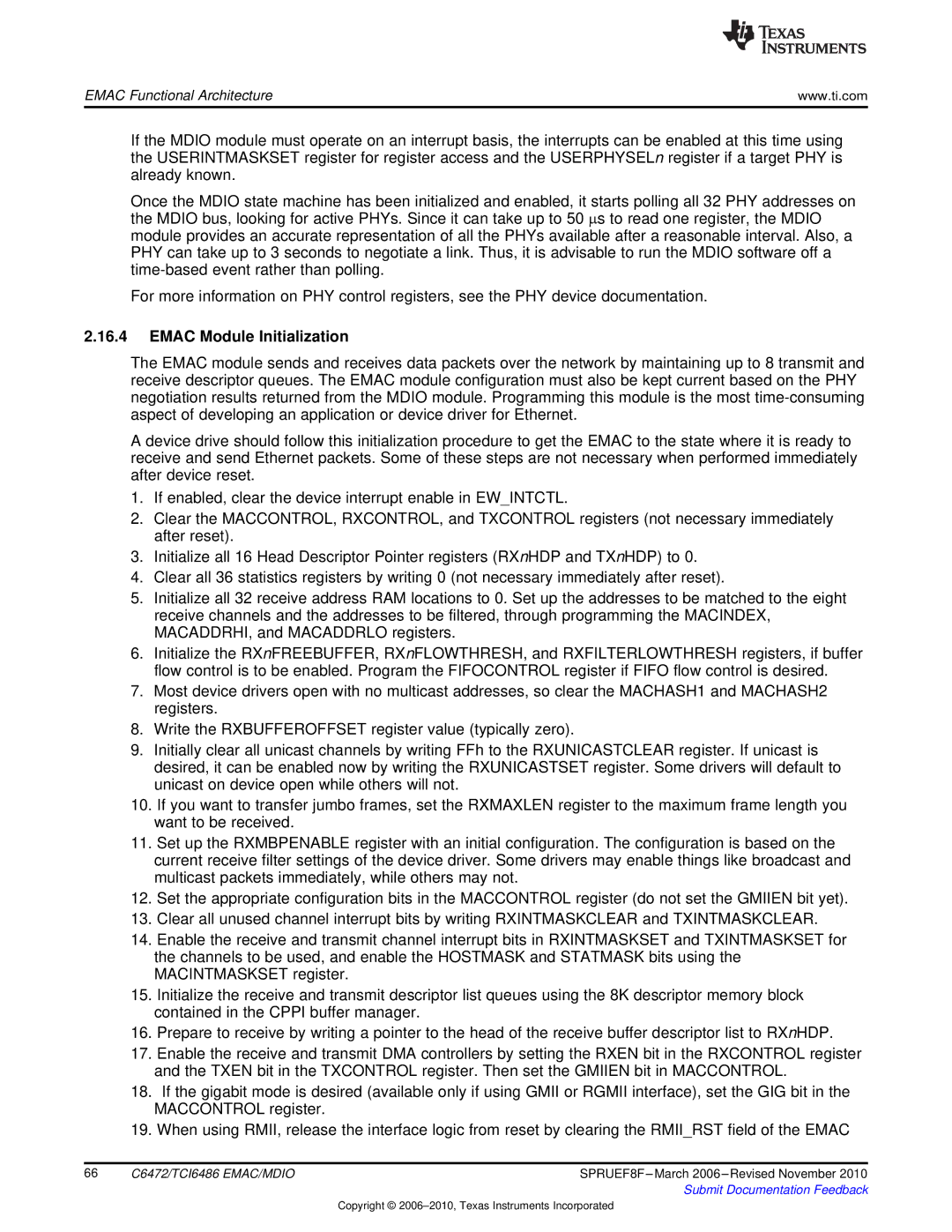
EMAC Functional Architecture | www.ti.com |
If the MDIO module must operate on an interrupt basis, the interrupts can be enabled at this time using the USERINTMASKSET register for register access and the USERPHYSELn register if a target PHY is already known.
Once the MDIO state machine has been initialized and enabled, it starts polling all 32 PHY addresses on the MDIO bus, looking for active PHYs. Since it can take up to 50 μs to read one register, the MDIO module provides an accurate representation of all the PHYs available after a reasonable interval. Also, a PHY can take up to 3 seconds to negotiate a link. Thus, it is advisable to run the MDIO software off a
For more information on PHY control registers, see the PHY device documentation.
2.16.4EMAC Module Initialization
The EMAC module sends and receives data packets over the network by maintaining up to 8 transmit and receive descriptor queues. The EMAC module configuration must also be kept current based on the PHY negotiation results returned from the MDIO module. Programming this module is the most
A device drive should follow this initialization procedure to get the EMAC to the state where it is ready to receive and send Ethernet packets. Some of these steps are not necessary when performed immediately after device reset.
1.If enabled, clear the device interrupt enable in EW_INTCTL.
2.Clear the MACCONTROL, RXCONTROL, and TXCONTROL registers (not necessary immediately after reset).
3.Initialize all 16 Head Descriptor Pointer registers (RXnHDP and TXnHDP) to 0.
4.Clear all 36 statistics registers by writing 0 (not necessary immediately after reset).
5.Initialize all 32 receive address RAM locations to 0. Set up the addresses to be matched to the eight receive channels and the addresses to be filtered, through programming the MACINDEX, MACADDRHI, and MACADDRLO registers.
6.Initialize the RXnFREEBUFFER, RXnFLOWTHRESH, and RXFILTERLOWTHRESH registers, if buffer flow control is to be enabled. Program the FIFOCONTROL register if FIFO flow control is desired.
7.Most device drivers open with no multicast addresses, so clear the MACHASH1 and MACHASH2 registers.
8.Write the RXBUFFEROFFSET register value (typically zero).
9.Initially clear all unicast channels by writing FFh to the RXUNICASTCLEAR register. If unicast is desired, it can be enabled now by writing the RXUNICASTSET register. Some drivers will default to unicast on device open while others will not.
10.If you want to transfer jumbo frames, set the RXMAXLEN register to the maximum frame length you want to be received.
11.Set up the RXMBPENABLE register with an initial configuration. The configuration is based on the current receive filter settings of the device driver. Some drivers may enable things like broadcast and multicast packets immediately, while others may not.
12.Set the appropriate configuration bits in the MACCONTROL register (do not set the GMIIEN bit yet).
13.Clear all unused channel interrupt bits by writing RXINTMASKCLEAR and TXINTMASKCLEAR.
14.Enable the receive and transmit channel interrupt bits in RXINTMASKSET and TXINTMASKSET for the channels to be used, and enable the HOSTMASK and STATMASK bits using the MACINTMASKSET register.
15.Initialize the receive and transmit descriptor list queues using the 8K descriptor memory block contained in the CPPI buffer manager.
16.Prepare to receive by writing a pointer to the head of the receive buffer descriptor list to RXnHDP.
17.Enable the receive and transmit DMA controllers by setting the RXEN bit in the RXCONTROL register and the TXEN bit in the TXCONTROL register. Then set the GMIIEN bit in MACCONTROL.
18.If the gigabit mode is desired (available only if using GMII or RGMII interface), set the GIG bit in the MACCONTROL register.
19.When using RMII, release the interface logic from reset by clearing the RMII_RST field of the EMAC
66 | C6472/TCI6486 EMAC/MDIO | SPRUEF8F |
|
| Submit Documentation Feedback |
Copyright ©
